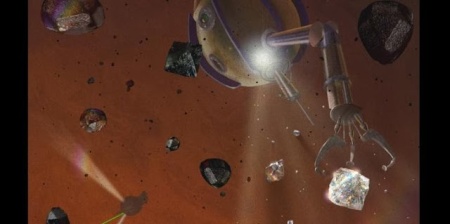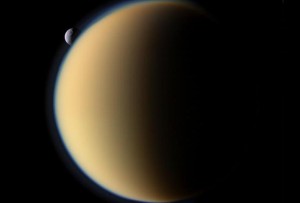Who was the woman who saved the US space race?
Leave a CommentThis video is from the American Chemical Society series, “Reactions”
This video is from the American Chemical Society series, “Reactions”

It’s raining diamonds! According to some researchers the heat, pressure and chemical conditions on Saturn and Jupiter may be conducive to the production of diamonds – diamonds that may rain down through the atmosphere.
This research, reported by David Reneke on his World of Space and Astronomy, was recently presented at the American Astronomical Society’s Division for Planetary Sciences held in Denver, Colorado.
This research opens up new and interesting ways to look at the composition and mineral wealth of the solar system.
The Cassini was launched in 1997 to study Saturn and its moons. It contains a battery of scientific instruments that have been sending back data about the Saturn system since 2004.
Reported by BBC News, Cassini recently sent back information that it detected on Saturn’s moon, Titan, propene or propylene – a building block of POLYPROPYLENE – a commonly used plastic. What makes this discovery special is that it is the first time this constituent of polypropylene has been found anywhere outside of Earth.
NASA commented:
On Earth, this molecule, which comprises three carbon atoms and six hydrogen atoms, is a constituent of many plastics.
It is the first definitive detection of the plastic ingredient on any moon or planet, other than our home world, says the US space agency.
Other interesting chemicals detected on Titan include propane, and ethylene – a constituent of another common polymer – polyethylene.
This is only part of the chemical story. NASA scientists hypothesize that Saturn’s huge magnetic field and the effects of the sun’s ultra-violet light may yield more exotic chemistry on Titan and Saturn’s other moons.
 Saturn’s moon,Titan, eclipsing Tethys, another one of Saturn’s sixty-two moons
Saturn’s moon,Titan, eclipsing Tethys, another one of Saturn’s sixty-two moons
These words may be from science fiction, but fiction is coming closer to reality as advances in technology expand our view of the universe.
Read about the discoveries of earth-like planets by NASA’s Kepler spacecraft as reported on Sci-Curious, the blog of the C-Debi STC:
Reblogged here with thanks.
Feel like moving? Well there might be a destination. The adventure to get there might be something similar to the marine turned Avatar in the movie bearing that same name. Then again, perhaps we’ll figure out how to travel “Star Trek style.” Beam me up, Scotty!
Welcome to Kepler 62f. (That’s as good a name as “earth!”) How did this world get it’s name–from the NASA Kepler space craft that discovered it. I should actually say “them” as there are 5 planets circling this star that is somewhat dimmer than our sun. Kepler 62f is special because it is one of two planets that seem made of rock and may have oceans. Intrigued? Read Dennis Overbye’s story “Two Promising Planets to Live, 1,200 Light-Years from Earth“ in the New York Times.
There’s history here, too. Johannes Kepler born in 1571 to a poor family in Weil der Stadt, Württemberg. He was a sickly child but his intelligence earned him a scholarship to attend University of Tübingen where he was delighted with the work of Copernicus. The history and NASA connection you can read. Eventually and recently, Kepler met Einstein by showing gravity bending as an extremely dense dwarf star crosses in front of a red star.
By the way, my job is not to explain all of this to you–simply to wet your apetite for it. History meets science meets science fiction today. So, here’s the personal question: Where are you going? The universe is an expansive place with concepts smaller and larger than the mind can grasp or imagine. But isn’t it fun to learn more and keep trying!
Illustration above is:
An artist’s impression of a sunrise on Kepler 62f. The two outer planets of the Kepler 62 system may lie in the habitable zone, where liquid water could exist on the surface.American Association for the Advancement of Science